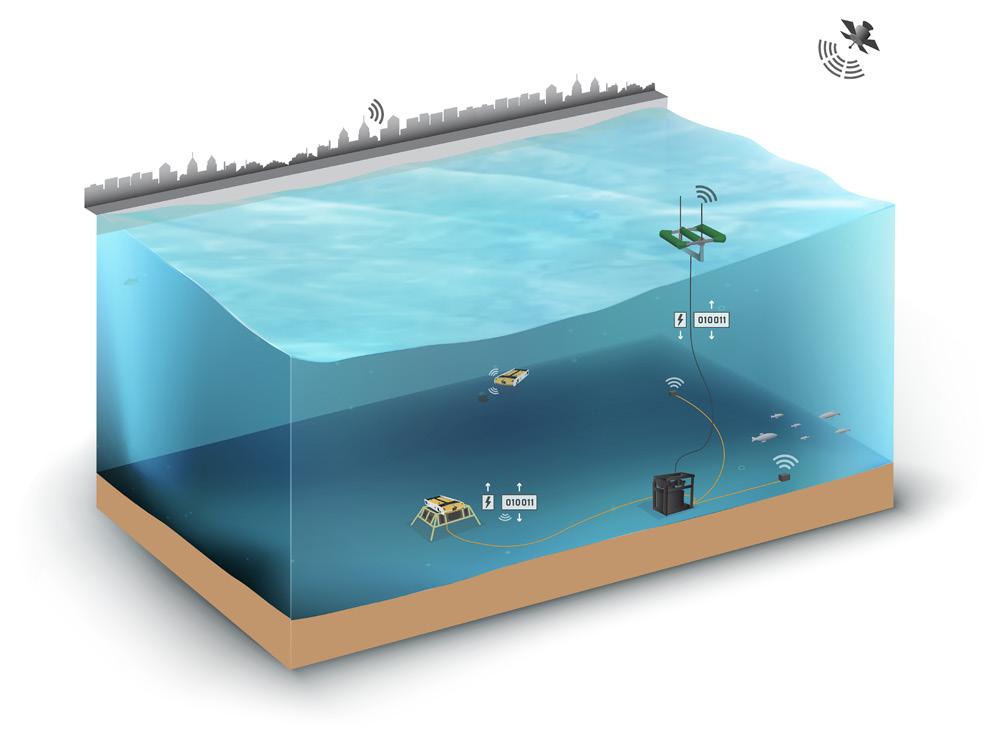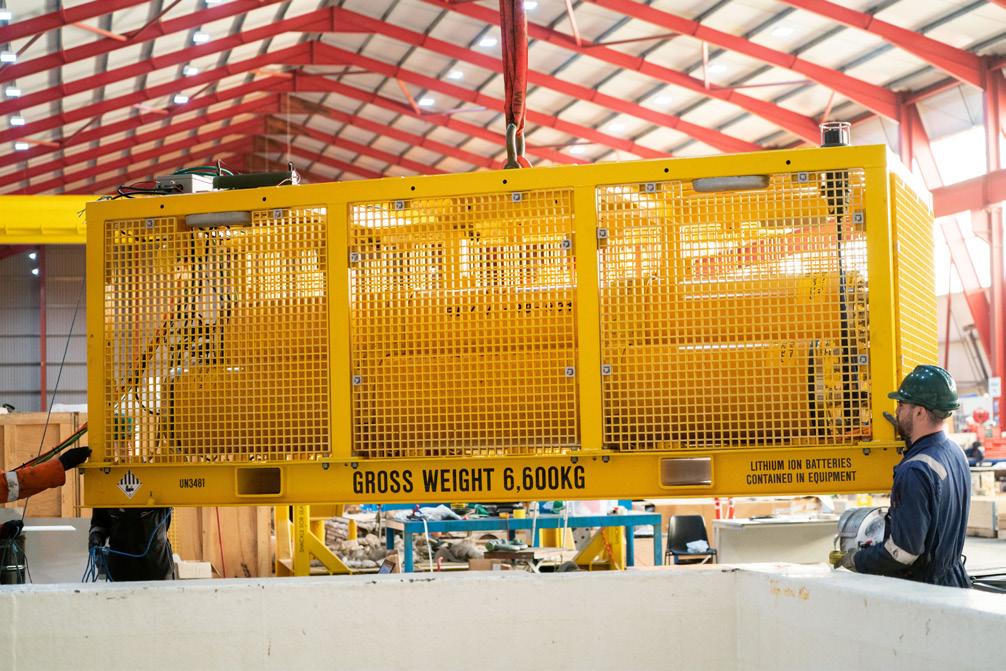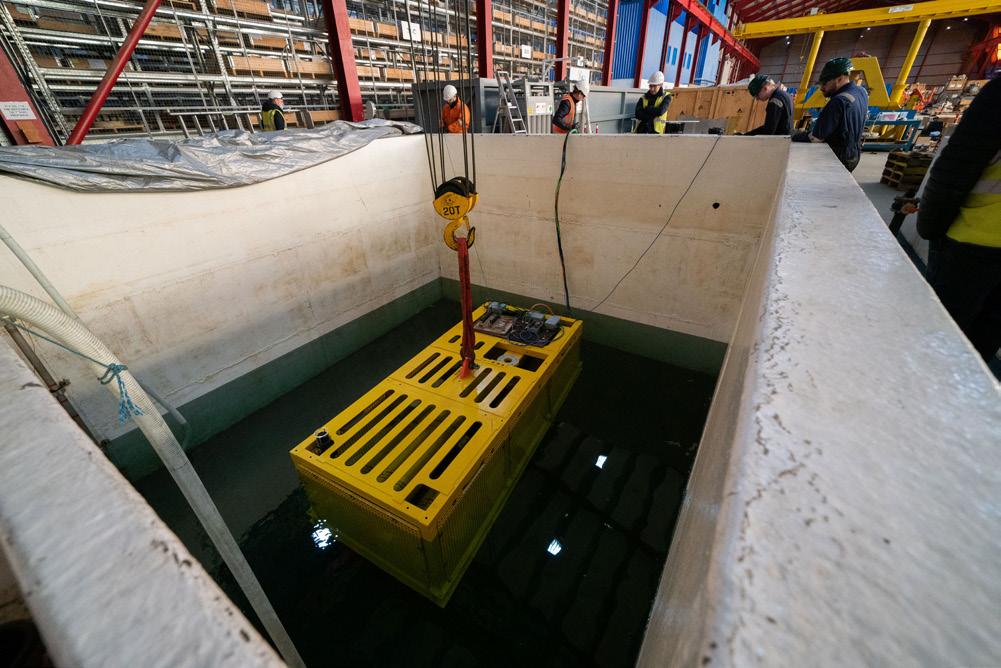
8 minute read
Energy storage under the sea
Robert Heron and Roy MacLean,
Verlume, UK, discuss the first steps taken to integrate battery energy storage into the energy mix, particularly in offshore environments.
With an ever-increasing focus and scrutiny around the carbon intensity of the world’s energy mix, battery energy storage has emerged as a key element of a successful transition to cleaner energy. As the use of phrases such as decarbonisation and electrification rise across all areas of energy production, what action is being taken now to integrate this enabling technology within the energy transition?
In the offshore environment, battery energy storage can use its advantages in efficiency and reliability of power supply to enable electrification, having been identified as a valuable way of decreasing the carbon footprint associated with renewable offshore energy applications and operations in line with the Paris and Glasgow agreements.

Battery energy storage can overcome the challenges associated with renewable energy intermittency, as well as increasing safety by enabling more remote and autonomous operations. With the use of battery energy storage in an offshore environment, a local power enabler is readily available through the combination of battery energy storage, an intelligent energy management system, and renewable energy producing assets.
Land-based market growth
Being heralded as the missing link between the varying, intermittent renewable sources of power, and the reliability of 24-h consistent supply, the many advantages of battery energy storage are being recognised on a worldwide scale. However, over recent years, much of the rapid advancements within the battery energy storage market have been within land-based applications, including through capacity improvements and investment at pace.
The increase in investment in the sector has been vast, with battery firms raising US$17 billion in corporate funding in 2021.¹ The scale of battery energy storage projects is also intensifying. The world’s largest energy storage facility, operated by Vistra, is set to become even bigger with plans announced to add further capacity of 1400 MWh. This would be in addition to today’s 1600 MWh of energy storage capacity at the company’s Moss Landing Energy Storage Facility.
In these land-based applications, battery energy storage technology can also decrease dependence on the grid which could be particularly useful during periods of extreme weather related to climate change. An example of this in action is Australia’s largest microgrid in Kalbarri which has received an AUS$15 million investment. Power from a 1 MW residential rooftop solar arrangement and a wind farm of 1.6 MW capacity is supported by a 5 MW battery energy storage system. The microgrid configurement, with integrated battery energy storage, means that the energy system can operate independently and act as an alternative to long-range power lines and feeders which are vulnerable to weather-related damage.
It is clear that the value of battery energy storage is being more widely understood and accepted as a crucial element of the energy transition. As mentioned, the advantages and opportunities for the use of battery energy storage within the offshore environment have not been widely capitalised on, not least at the same scale as the onshore applications noted above.

Figure 1. Project configuration for the offshore sea trial in Hawaii. Image courtesy of C-Power.
Figure 2. Verlume’s Halo subsea energy storage unit in Aberdeen, Scotland.

A world-first project in Hawaii
Verlume is working at the forefront of the integration of battery energy storage and accompanying intelligent energy management systems within offshore renewable energy developments. A key element which will further support the roll-out of battery energy storage technology at scale in this environment will be efficient intelligent energy management systems which can effectively control reliable and resilient power delivery.
To enable reliable, local, renewable power generation as well as more environmentally and economically viable operations, Verlume’s Halo subsea battery energy storage device is currently part of a world-first autonomous offshore power project. The sea trial will take place in 1Q22 at the US Navy Wave Energy test site, off the coast of the Hawaiian island of Oahu.
Verlume is working with project owner Columbia Power Technologies Inc (C-Power), a US wave energy developer, with the support of the US Department of Energy, as well as Saab, BioSonics, and Franatech. Three key elements will be explored through the project: F Power generation.
F Energy storage and management.
F Power delivery.
Verlume’s Halo device will provide seabed energy storage and management, and power delivery. Halo will ensure continuous energy availability for remote subsea operations, by providing the power, data, and communication interfaces for multiple underwater payloads. It will also act as the seafloor base unit and anchor for the wave energy converter,
as well as providing the communications gateway to the underwater payloads.
After its arrival to the test site in Hawaii, Halo will be integrated with C-Power’s wave energy convertor umbilical and the communications network to form an autonomous offshore power system (AOPS). The AOPS offshore sea trial is designed to provide power to support unmanned and autonomous offshore activities, including the use of underwater vehicles, sensor packages, and operating equipment with no tether to shore or fixed offshore installation.
Taking the plunge with battery energy storage
There are a number of factors to consider when adapting battery energy storage technology for use in the offshore and underwater environments. Halo was designed with these factors in mind, drawing heavily on the team’s background and expertise in subsea technology and the impacts of the harsh marine environment.
The Halo frame has removable panels with consideration to the sizing of the holes in the sides and the top of the unit, to conform to marine licensing requirements and to prevent any undue harm to marine life that come into contact with the device. There are three environmental housings which are secured to a base frame, two of which are battery enclosures and the third of which houses the intelligent energy management system (IEMS). The IEMS provides energy security by autonomously maximising the different states of charge in real-time, providing an efficient, resilient, and dependable system.
Within this project, there is a single input from the wave energy converter to Halo, through a dynamic umbilical connection. The Halo then distributes power to up to seven outputs, comprising both AC and DC at various voltage levels. The overall energy capacity of Halo is 51 kWh with the total output power at any given time being limited to 3 kW in order to control the battery’s discharge and prolong its life. The capacity for Halo in this project is dependent on the number and type of batteries used; however, Halo devices can be scaled to much larger capacities without affecting the core system architecture.
In terms of operations, Halo is designed with a footprint small enough to be transported by road and fits into a standard 20 ft shipping container. During deployment, Halo does not require any large scale construction vessels. Due to it being designed to be small and relatively lightweight, Halo can be deployed from a small commercial workboat, or similar.
The energy storage system is lithium-ion based but the configuration is flexible so that it can be adaptable for other battery types. Battery technology is constantly improving, so horizon scanning is an ongoing process at Verlume.
Primary communications are provided via a fibre optic link to the wave energy converter, which provides the surface gateway for communications to shore using a satellite, cellular, or radio link. An integrated acoustic modem provides a backup wireless communications link through the water column to the surface. There is also an isolator switch which can be switched on at the surface, or underwater using a remotely operated vehicle.

Figure 3. Wet pit testing being conducted on the Halo unit.
Simulating project parameters
For the factory acceptance testing, in the absence of the actual wave energy convertor, a sophisticated programmable power supply was used to accurately replicate the power characteristics of the wave device. The performance of the system was assessed using different simulated sea states from glassy calm to rough seas. The Halo was tuned to maximise the efficient use of this power during the weeks of testing.
Alongside this, custom-built load simulators were used to accurately replicate the power and communications requirements of the various subsea loads, such as autonomous underwater vehicles and sensors.
System testing was conducted in a water filled test pit. In order to imitate the tropical waters off the coast of Hawaii, the water temperature was raised to 25˚C. Halo’s autonomous operation was verified following successful completion of the testing in December 2021.
On arrival in Hawaii, Halo will be tested as part of a site receipt test and stored ready for deployment. Once deployed, Halo’s performance will be monitored from the Verlume facility in Aberdeen, Scotland.
The future of battery energy storage
The learnings that come from this project will be significant for further advancing and proving the use case for offshore battery energy storage, providing a real-world example to de-risk the technology. The world-leading element within this project is that the sea trial will be the first-ever demonstration of the integration of a selection of novel subsea technologies.
It is evident that further demonstration projects and trials such as these will be required to scale the systems to the same extent as land-based battery energy storage projects, taking world-first steps towards decarbonising and electrifying operations, as well as reducing the overall carbon intensity of the energy mix in the offshore environment.










